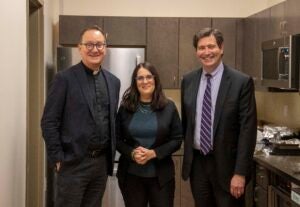What a Kosher Kitchen Means To Jewish Life at GU

(front to back) Hannah Kosc (SFS’ 23), Lily Rubenstein (C’22), Sadie Morris (SFS’22), Julia & Liebell-McLean (SFS’22) in the kosher kitchen preparing hamentaschen for Purim.
“Food is a staple of any community and Jews are no different,” said Idan Chazan (C’22).
In Jewish religious and communal life, meals are central to the spiritual and social experience of being Jewish, and most of the Georgetown Jewish (GUish) community would agree. Cooking in preparation for Shabbat is a tranquil way to welcome in the day of rest; the same holds true on the Hilltop.
“Cooking food and sharing meals was central to my sense of community within Jewish Life when I first arrived at Georgetown,” said Lily Rubinstein (C’22). I remember my first few semesters on campus baking challah and hamentaschen in Bayit apartments (a residential community at Georgetown designed to celebrate and explore Jewish culture), sharing dinners in the homes of seniors in the Burleith neighborhood, and having long conversations around the dinner table each week at Shabbat.
Kashrut, Jewish dietary law regulates what food Jews can eat and how the food is prepared. For this reason, having the new kosher kitchen on campus is very exciting. “The kitchen allows Jewish students to practice their faith to the level they choose, provides a space for Jewish Hoyas to bond, and sends a message to the GUish community that they are welcome among the other faith groups on campus,” said Chazan.
As a senior who keeps kosher, Chazan can attest to the difficulty of keeping kosher at Georgetown. During his freshman year on the meal plan, options to have food that fit his dietary restrictions were limited on campus.
“Having access to a kosher kitchen of our own, in a space that is truly ours, is so meaningful,” said Rubinstein. “It will allow us to welcome more students to our programming, both in terms of granting us more physical space and in terms of meeting the Kashrut standards of more students,” she added.

Rabbi Rachel Gartner with Fr Mark Bosco SJ, VP of Mission & Ministry, & Erik Smulson, VP for Public Affairs at the launch of the kosher kitchen.
Coming off a truly wonderful Purim celebration, which featured the Jewish community’s inaugural hamentaschen bake this year, Rabbi Rachel Gartner said it brings her great joy that the kosher kitchen is already serving the community so well. “The delightful, familiar aromas, the relaxed conversation, the sounds of rolling pins rolling, and the tastes of warm, sweet Jewish soul food were true balms for the spirit in midst of all that is going on in our world,” she added.
The kitchen was officially opened in February (pictured above), Rabbi Gartner said that the occasion brought tears to her eyes and that serving student community-baked challah at Shabbat was simply a blessing.
“The kosher kitchen in Makóm demonstrates a commitment from the university and Rabbi Rachel to ensure that the Jewish community at Georgetown can practice Judaism as they choose,” said, Rubinstein.
“On behalf of current and future generations of Jewish Hoyas, I extend my tremendous gratitude to the donor families whose generosity and love enabled us to make this long-time dream a reality,” said Rabbi Gartner.
Hazak hazak v’nitchazek.
By Idan Chazan (C’22), Lily Rubinstein (C’22), and Rabbi Rachel Gartner, director of Jewish Life.